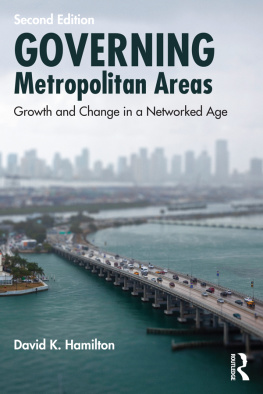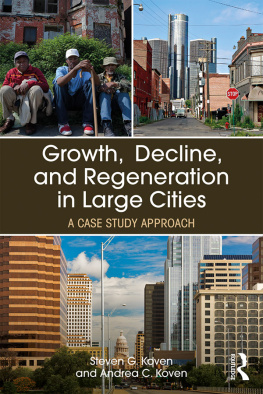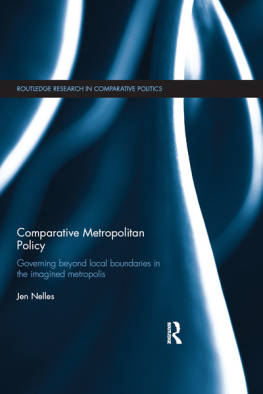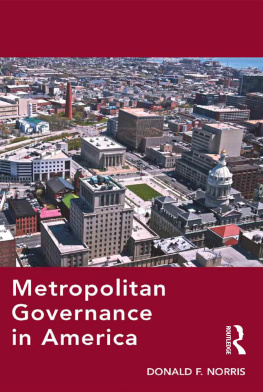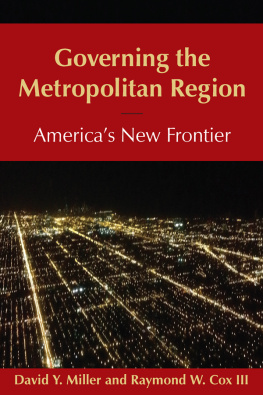Governing Metropolitan Areas
Interest and research on regionalism has soared in the last decade. Local governments in metropolitan areas and civic organizations are increasingly engaged in cooperative and collaborative public policy efforts to solve problems that stretch across urban centers and their surrounding suburbs. Yet there remains scant attention in textbooks to the issues that arise in trying to address metropolitan governance. Governing Metropolitan Areas describes and analyzes structure to understand the how and why of regionalism in our global age. The book covers governmental institutions and their evolution to governance, but with a continual focus on institutions. David K. Hamilton provides the necessary comprehensive, in-depth description and analysis of how metropolitan areas and governments within metropolitan areas developed, efforts to restructure and combine local governments, and governance within the polycentric urban region.
This second edition is a major revision to update the research and current thinking on regional governance. While the text still provides background on the historical development and growth of urban areas and governments efforts to accommodate the growth of metropolitan areas, this edition also focuses on current efforts to provide governance through cooperative and collaborative solutions. It also provides information on how regional governance outside the United States has evolved and how other countries are approaching regional governance.
David K. Hamilton is director of the MPA program at Texas Tech University. Current research interests include democracy and efficiency, patronage and human resource management, comparative regional governance, and local government reform. He is co-editor of Regional Policies for Metropolitan Livability (2008) and author of Governing Metropolitan Areas: Response to Growth and Change (1999). He has published numerous articles on patronage, human resources, and regional topics in leading journals.
Governing Metropolitan Areas
Growth and Change in a Networked Age
Second edition
David K. Hamilton
First published 2014
by Routledge
711 Third Avenue, New York, NY 10017
and by Routledge
2 Park Square, Milton Park, Abingdon, Oxon OX14 4RN
Routledge is an imprint of the Taylor & Francis Group, an informa business
2014 David K. Hamilton
The right of David K. Hamilton to be identified as author of this work has been asserted by him/her in accordance with sections 77 and 78 of the Copyright, Designs and Patents Act 1988.
All rights reserved. No part of this book may be reprinted or reproduced or utilised in any form or by any electronic, mechanical, or other means, now known or hereafter invented, including photocopying and recording, or in any information storage or retrieval system, without permission in writing from the publishers.
Trademark notice: Product or corporate names may be trademarks or registered trademarks, and are used only for identification and explanation without intent to infringe.
Library of Congress Cataloging in Publication Data
Hamilton, David K.
Governing metropolitan areas : response to growth and change / David
Hamilton.Second edition.
pages cm
1. Metropolitan governmentUnited States. I. Title.
JS422.H285 2014
320.850973-dc23
2013043427
ISBN: 978-0-203-12187-0 (ebk)
ISBN: 978-0-415-89935-2 (pbk)
ISBN: 978-0-415-89934-5 (hbk)
Typeset in Bembo
by RefineCatch Limited, Bungay, Suffolk
Contents
Since the publication of Governing Metropolitan areas: Response to Growth and Change in 1999, interest and research on regionalism has significantly increased. There is increasing focus in the college classroom, among practitioners and in society on policy issues relating to regional governance. Courses on regionalism are increasing in political science, public administration, urban studies and sociology curricula at both the undergraduate and graduate level. Local governments in metropolitan areas and civic organizations are increasingly engaged in cooperative and collaborative public policy efforts. Residents in metropolitan areas are becoming more vocal in demanding solutions to regional governance issues.
Metropolitan areas have taken on new significance as the economic engines of the nation. Local governments in metropolitan areas that previously competed with each other are now cooperating with each other and collaborating with civic and private sector leaders in networks. These networks are vehicles that address regional policy issues and are also used to organize competition with other metropolitan areas in the United States and in other countries for development. We have become a networked society on a global scale. Hence the slight change in the title of this edition of the book to reflect the reality of the networked age.
The 1999 edition of the book was a comprehensive, in-depth description and analysis of how metropolitan areas and governments within metropolitan areas developed, efforts to restructure and combine local governments, and governance within the polycentric urban region. This edition follows the same model as the first edition. It updates the literature since the first edition and adds significant material to reflect the new governing directions. While metropolitan areas were experimenting in the 1990s with the concepts of governance as opposed to government structure reform, in the twenty-first century these concepts have been embraced. Governance in a networked society is a major focus of the book and is reflected in a number of the chapters. In addition, a chapter on regional governance in selected metropolitan areas in other countries has been added to reflect the global age in which metropolitan areas compete across national borders for development.
The updated version continues to be a thorough discussion of the historical development of metropolitan areas and the problems and issues in the governance of metropolitan areas. It expands on the framework that I introduced in the first edition to apply in the study of centralized and decentralized local and regional governing systems. This framework is used to categorize and study the various responses to regional governing pressures. The various responses are then analyzed in depth with the focus on cooperative and collaborative approaches to regional governance. The framework provides a basis to clarify and understand these responses to the regional governing pressures. This edition not only updates the current research and thinking on regional government and governance, it provides mini-case studies and examples to illustrate the concepts.
Two opposing forces, one centralizing and the other decentralizing, have interacted to shape political boundaries in urban areas. At various times in our nations history, each force has been dominant. During most of the nineteenth century, centralized government responses dominated. For most of the twentieth century, decentralized government responses were dominant. In the twenty-first century a new paradigm has emerged. This is a governance response that is based on a decentralized model but in some instances has a centralizing effect and in other instances continues to be a decentralized response. The shift is now how to address regional policy issues, not how to restructure local government. The governing focus is also more inclusive in bringing together both government and nongovernment leaders who can help address regional problems. These various responses to regional governing pressures are analyzed in the book.


